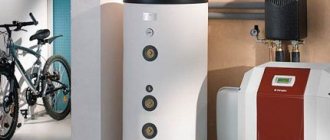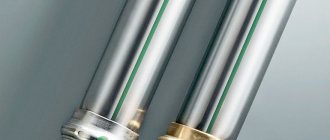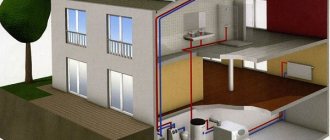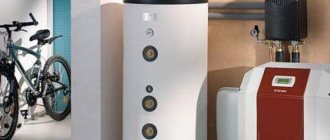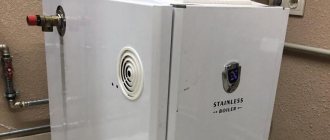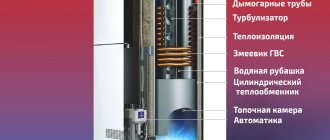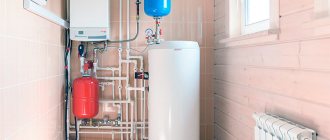Many people associate electric heating of a home with the installation of appropriate water boilers with heating elements, convectors, or laying heated film floors. However, there are many more options. In modern private homes, electrode or ion boilers are installed, in which a pair of primitive electrodes transfer energy to the coolant without any intermediaries.
Ion-type heating boilers were first developed and implemented in the Soviet Union to heat submarine compartments. The installations did not cause additional noise, had compact dimensions, there was no need to design exhaust systems, and they effectively heated sea water, which was used as the main coolant.
The heat carrier, which circulates through the pipes and enters the working tank of the boiler, comes into direct contact with the electric current. Ions charged with different signs begin to move chaotically and collide. Thanks to the resistance formed, the coolant heats up.
- 1 History of appearance and principle of operation
- 2 Characteristics: advantages and disadvantages
- 3 Design and technical characteristics
- 4 Video guide
- 5 Simple DIY ion boiler
- 6 Features of installation of ion boilers
- 7 Manufacturers and average cost
History of appearance and principle of operation
Within just 1 second, each of the electrodes collides with the others up to 50 times, changing its sign. Thanks to the action of alternating current, the liquid does not divide into oxygen and hydrogen, maintaining its structure. An increase in temperature entails an increase in pressure, which forces the coolant to circulate.
To achieve maximum efficiency of the electrode boiler, you will have to constantly monitor the ohmic resistance of the liquid. At classic room temperature (20-25 degrees), it should not exceed 3 thousand Ohms.
Do not pour distilled water into the heating system. It does not contain any salts in the form of impurities, which means you should not expect it to be heated in this way - there will be no environment between the electrodes to form an electrical circuit.
Read additional instructions on how to make your own electrode boiler here
What is an overheat sensor
In addition to the draft sensor, there is also an overheat sensor. It is a device that protects water heated by the boiler from boiling, which occurs when the temperature rises above 100 degrees Celsius.
When triggered, such a device turns off the boiler. The overheat sensor only works properly if installed correctly. An increase in water temperature without this device would threaten the failure of the gas boiler.
The overheating sensor monitors the temperature increase in the heating circuit. It is installed at the outlet of the heating circuit heat exchanger. When the critical temperature is reached, it opens the contacts and turns off the boiler.
Reasons for triggering the overheating sensor:
- Such a device can work if the water in the column heats up too much;
- If the sensor contact is poor;
- Due to its malfunction;
- If the sensor has poor contact with the pipe.
In order to make the heating sensor more sensitive, heat-conducting paste is used. When overheating, the sensor blocks the operation of the boiler. Modern devices are able to indicate a fault code on the display.
Characteristics: advantages and disadvantages
An ion-type electrode boiler is characterized not only by all the advantages of electric heating equipment, but also by its own characteristics. The extensive list includes the most significant:
- The efficiency of installations tends to the absolute maximum – not less than 95%
- No pollutants or ion radiation harmful to humans are released into the environment
- High power in a housing that is relatively small in size compared to other boilers
- It is possible to install several units at once to increase productivity, or separate installation of an ion-type boiler as an additional or backup heat source
- Low inertia makes it possible to quickly respond to changes in ambient temperature and fully automate the heating process through programmable automation
- There is no need to install a chimney pipe
- The equipment is not harmed by an insufficient amount of coolant inside the working tank
- Voltage surges do not affect heating performance and stability
You can find out how to choose an electric boiler for heating here
Of course, ion boilers have numerous and very significant advantages. If you do not take into account the negative aspects that arise more often during the operation of the equipment, all benefits are lost.
Among the negative aspects it is worth noting:
- To operate ion heating equipment, you cannot use DC power sources, which will cause electrolysis of the liquid
- It is necessary to constantly monitor the electrical conductivity of the liquid and take measures to regulate it
- It is necessary to ensure reliable grounding. If it breaks down, the risk of being shocked increases significantly
- It is prohibited to use heated water in a single-circuit system for other needs.
- It is very difficult to organize efficient heating with natural circulation; installation of a pump is mandatory
- The temperature of the liquid should not exceed 75 degrees, otherwise the consumption of electrical energy will increase sharply
- Electrodes wear out quickly and need to be replaced every 2-4 years
- Repair and commissioning work cannot be carried out without the involvement of an experienced technician.
Read about other methods of electric heating at home here
Control methods
Today, a variety of sensors allows the use of various control methods. For example, to control the combustion process of fuel in a liquid or gaseous state, direct and indirect control methods can be used. The first method includes methods such as ultrasonic or ionization. As for the second method, in this case the flame control relay sensors will monitor slightly different quantities - pressure, vacuum, etc. Based on the data received, the system will conclude whether the flame meets the specified criteria.
For example, in small gas heaters, as well as in domestic heating boilers, devices are used that are based on photoelectric, ionization or thermometric flame control methods.
Device and technical characteristics
The design of the ion boiler, at first glance, is complex, but it is simple and not forced. Externally, it is a seamless steel pipe, which is covered with a polyamide electrical insulating layer. Manufacturers have tried to protect people as much as possible from electric shock and leaks of expensive energy.
In addition to the tubular body, the electrode boiler contains:
- The working electrode, which is made of special alloys and is held in place by protected polyamide nuts (in models operating from a 3-phase network, three electrodes are provided at once)
- Coolant inlet and outlet pipes
- Ground terminals
- Terminals supplying power to the chassis
- Rubber insulating pads
The shape of the outer body of ion heating boilers is cylindrical. Most common household models meet the following characteristics:
- Length – up to 60 cm
- Diameter – up to 32 cm
- Weight - about 10-12 kg
- Equipment power – from 2 to 50 kW
For domestic needs, compact single-phase models with a power of no more than 6 kW are used. There are enough of them to fully provide heat to a cottage with an area of 80-150 sq. m. For large industrial areas, 3-phase equipment is used. A 50 kW installation is capable of heating a room up to 1600 sq. m.
However, the electrode boiler works most efficiently in conjunction with control automation, which includes the following elements:
- Starter block
- Surge protection
- Controller
Additionally, GSM control modules can be installed for remote activation or deactivation. Low inertia allows you to quickly respond to temperature fluctuations in the environment.
Due attention should be paid to the quality and temperature of the coolant. The optimal liquid in a heating system with an ion boiler is considered to be heated to 75 degrees. In this case, power consumption will correspond to that specified in the documents. Otherwise, two situations are possible:
- Temperature below 75 degrees - electricity consumption decreases along with the efficiency of the installation
- Temperature above 75 degrees - electricity consumption will increase, however, the already high efficiency indicators will remain at the same level
Electrode heating equipment market
The most common electrode boiler units in Russia are the following brands:
— "GALAN" (Russia);
— "EOU" (SPD-FO O.A. Goncharenko, Ukraine);
— "STAFOR EKO" (Latvia).
Manufacturers provide up to two years of warranty on heating units subject to proper operation. The service life of the boiler itself is more than 10 years with regular replacement of the current electrodes every 3 years.
The approximate cost of a 2 kW heating unit is 9.5–
10 thousand rubles, including the necessary control and automation unit
-
6.5
-
7 thousand rubles.
Simple DIY ion boiler
Having become familiar with the features and principle by which ion heating boilers operate, it is time to ask the question: how to assemble such equipment with your own hands? First you need to prepare the tools and materials:
- Steel pipe with a diameter of 5-10 cm
- Ground and neutral terminals
- Electrodes
- Wires
- Metal tee and coupling
- Persistence and desire
Before you start putting everything together, there are three very important safety rules to remember:
- Only the phase is supplied to the electrode
- Only the neutral wire is supplied to the housing
- Reliable grounding must be provided
To assemble an ion electrode boiler, just follow the following instructions:
- First, a pipe 25-30 cm long is prepared, which will act as a body
- Surfaces must be smooth and free of corrosion, nicks at the ends must be cleaned
- On the one hand, electrodes are installed using a tee
- A tee is also necessary to organize the outlet and inlet of the coolant
- On the second side they make a connection to the heating main
- Install an insulating gasket between the electrode and the tee (heat-resistant plastic is suitable)
- To achieve a tight seal, the threaded connections must be precisely adjusted to each other.
- To secure the zero terminal and grounding, 1-2 bolts are welded to the body
Having put everything together, you can embed the boiler into the heating system. Such homemade equipment is unlikely to be able to heat a private home, but for small utility areas or a garage it will be an ideal solution. You can cover the installation with a decorative casing, while trying not to restrict free access to it.
Things to remember
When planning to install an electrode boiler, remember a few important points to ensure that your heating system is durable, safe and highly efficient:
1. Do not neglect the requirements for installation and connection of the boiler unit; take responsibility for the safety and grounding of electrical equipment.
2. If the heating circuit is filled with antifreeze, ensure the tightness and strength of the detachable connections due to its high fluidity. 3. Cover the supply and return pipelines with effective thermal insulation for optimal operation of the boiler unit. 4. The long service life of the heating circuit significantly reduces the efficiency and economy of the ion boiler installed to replace outdated equipment. When installing an electrode boiler, carry out a major overhaul of the existing heat supply system with the obligatory replacement of radiators with modern models of devices; 5. With a branched heat supply scheme, for example in multi-storey buildings, an effective solution would be to install several units on each floor or in each individual building. It will be somewhat more expensive, but more reliable in terms of operation. 6. Heated floors cannot be installed in heating systems with ion boiler units, since the maximum possible coolant temperature for it (45°C) will not allow the boiler to operate in optimal operating mode.
Features of installation of ion boilers
A prerequisite for installing ion heating boilers is the presence of a safety valve, pressure gauge and automatic air vent. The equipment must be placed in a vertical position (horizontal or at an angle are not allowed). At the same time, about 1.5 m of supply pipes are not galvanized steel.
The zero terminal is usually located at the bottom of the boiler. A grounding wire with a resistance of up to 4 ohms and a cross-section of over 4 mm is connected to it. You should not rely solely on RAM - it cannot help with current leakage. The resistance must also comply with the rules of the PUE.
If the heating system is completely new, there is no need to prepare the pipes - they must be clean inside. When the boiler crashes into an already operating main, it is necessary to flush it with inhibitors. The markets offer a wide range of products for removing deposits, salts and scale. However, each manufacturer of electrode boilers indicates those that it considers best for its equipment. Their opinion should be followed. By neglecting flushing, it will not be possible to establish the exact ohmic resistance.
It is very important to select heating radiators for the ion boiler. Models with a large internal volume are not suitable, since 1 kW of power will require more than 10 liters of coolant. The boiler will constantly work, wasting some of the electricity in vain. The ideal ratio of boiler power to the total volume of the heating system is 8 liters per 1 kW.
If we talk about materials, it is better to install modern aluminum and bimetallic radiators with minimal inertia. When choosing aluminum models, preference is given to primary type material (not remelted). Compared to the secondary one, it contains fewer impurities, reducing the ohmic resistance.
Cast iron radiators are the least compatible with an ion boiler, since they are the most susceptible to contamination. If it is not possible to replace them, experts recommend observing several important conditions:
- The documents must indicate compliance with the European standard
- Installation of coarse filters and sludge traps is required
- Once again, the total volume of coolant is produced and equipment suitable in terms of power is selected
Sensor, indicator of combustion, flame, fire, torch. Ignition, fuse, spark igniter. Scheme.
Flame presence indicator combined with an igniter on one electrode (10+)
Flame sensor and spark igniter on one electrode
| 1 | 2 |
Contents :: SearchSafety :: Help
For a gas burner I needed a spark ignition system and a fire indicator. Moreover, I really wanted the same electrode placed in the flame to operate both devices.
When developing the scheme, the following difficulties arose. Firstly, the gas burns without any serious glow. So it is not possible to use a photoresistor. I settled on using the effect of one-way plasma conductivity (the torch torch is the real plasma). To determine the presence of this effect, and, accordingly, the presence of a flame, it is necessary to place an electrode in the fire. An electrode is also needed for the spark discharge of the fuse. There is a temptation to use the same electrode. But, secondly, the direct approach of switching one electrode from the spark transformer to the sensor does not work, since I was unable to find a switch capable of withstanding several tens of kilovolts in igniter mode without piercing them to the sensor.
So we had to take a somewhat roundabout route. I connect the fire sensor in series with the ignition coil. During the fuse, I short-circuit the sensor. After switching to monitoring mode, the normally open contacts open. Voltage to control the flame is supplied to the electrode through the ignition coil. However, with its not very high inductance, it does not interfere with the passage of electric current with a frequency of 50 Hz from the network.
Here is a selection of materials:
The practice of electronic circuit design. The art of device development. Element base. Typical schemes. Examples of finished devices. Detailed descriptions. Online payment. Opportunity to ask questions to the authors
Burner control
LAE 10, LFE10 devices have become fairly common burner flame control sensors. As for the first device, it is used in systems that use liquid fuel. The second sensor is more versatile and can be used not only with liquid fuel, but also with gaseous fuel.
Most often, both of these devices are used in systems such as a dual burner control system. Can be successfully used in liquid fuel blower gas burner systems.
A distinctive feature of these devices is that they can be installed in any position, and can also be attached directly to the burner itself, on the control panel or on the switchboard
When installing these devices, it is very important to correctly lay the electrical cables so that the signal reaches the receiver without loss or distortion. To achieve this, you need to lay the cables from this system separately from other electrical lines
You also need to use a separate cable for these monitoring sensors.
When using any heating equipment that runs on natural fuels, you should always keep in mind the high risk of ignition or even explosion of this natural flammable substance.
Such a disaster can occur in situations in which a fire or torch may go out due to any reason. If the gas mixture continues to flow into the interior of the unit or the external space around it, one spark from an open flame will be enough for a fire or even an explosion to occur.
The most common cause of such cases is flame separation followed by extinction. This occurs when it is displaced from the outlet in the direction of the flow of the gas mixture. As a result, the firebox fills with gas, which leads to a bang or explosion. The cause of separation is the excess of the mixture flow speed over the fire spread speed.
Galan boiler is a product of conversion developments
The Galan heating unit is produced in accordance with the standards for military equipment, since this device is a conversion development of enterprises that produce devices for heating submarines and warships.
The Galan electrode boiler is a cylinder with a diameter of 60 mm and a length of 310 mm. Current is supplied to the unit using concentric tubular electrodes, then transferred to the coolant. The heated coolant is distributed by a circulation flow through pipes and radiators. In heating systems with Galan electrode devices, the circulation pump serves to accelerate the heating of the coolant, and then it can be turned off.
Advantages of the Galan brand ion boiler:
- presence of a built-in sensor for automatic heating control;
- high efficiency – up to 98%;
- low sensitivity to voltage changes;
- low power consumption;
- no need for approval for installation and use with boiler inspection;
- more compact dimensions than heating elements units;
- low cost - from 250-300 dollars.
A special antifreeze “Potok” was developed for these units. Additives to this liquid slow down the formation of scale on the walls of the device and the occurrence of metal corrosion processes.
When installing the electrical part of the heating circuit with your own hands, you must use the “Instructions” of Glavgosenergonadzor dated March 21, 1994, No. 42-6/8-ET.


